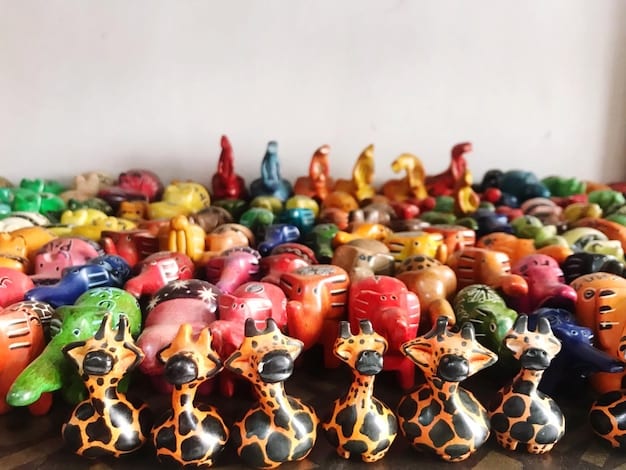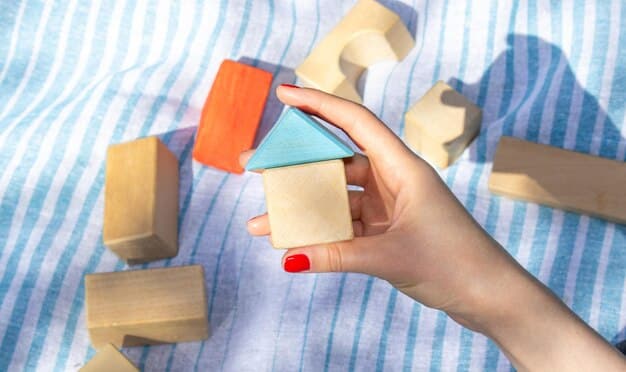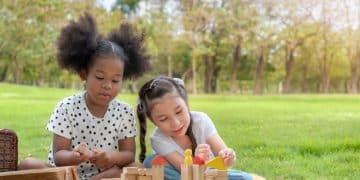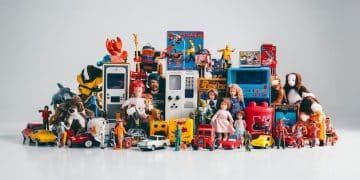Sustainable Toy Trends: 15% Growth Projected in 2025

The toy industry is undergoing a significant shift towards sustainability, with projections indicating a 15% growth in the sustainable toy segment by 2025, driven by increasing consumer awareness and demand for eco-friendly products.
The Toy Industry Trends: Why Sustainable Toys Are Projected to Grow by 15% in 2025 are becoming increasingly clear as parents and educators prioritize eco-friendly options. The shift marks a pivotal moment in how toys are manufactured, marketed, and perceived by consumers.
Understanding the Rise of Sustainable Toys
The growing demand for sustainable toys reflects a broader societal shift towards environmental consciousness. Consumers are becoming more aware of the impact of their purchasing decisions and are actively seeking products that align with their values.
Sustainable toys are not just about being eco-friendly; they also represent a commitment to ethical sourcing, responsible manufacturing, and minimizing environmental impact. This includes using materials like:
- Recycled plastics
- Organically grown cotton
- Sustainably harvested wood
The Environmental Impact of Traditional Toys
Traditional toys often rely on petroleum-based plastics and resource-intensive manufacturing processes, contributing to pollution and environmental degradation. Furthermore, many toys end up in landfills, where they can take hundreds of years to decompose.
- Plastic Waste: Traditional toys contribute significantly to plastic waste, which pollutes ecosystems and harms wildlife.
- Resource Depletion: The production of these toys often involves the extraction of non-renewable resources, leading to depletion and environmental damage.
- Carbon Footprint: The manufacturing and transportation of traditional toys generate a substantial carbon footprint, contributing to climate change.
Consumer Demand for Eco-Friendly Options
Parents, educators, and caregivers are increasingly seeking out sustainable toys as they become more aware of the environmental and health impacts of traditional toys. This demand is driven by a desire to:
- Reduce their family’s environmental footprint
- Support ethical and responsible businesses
- Provide children with safe and non-toxic play options
The rise in demand for sustainable toys is also fueled by increased awareness of the potential health risks associated with traditional toy materials, such as lead, phthalates, and BPA. Sustainable toys often prioritize natural, non-toxic materials that are safer for children.
In conclusion, the surge in popularity of sustainable toys mirrors a larger cultural movement towards ecological responsibility. As consumers become more conscious of their consumption habits, the demand for toys that are both safe for children and gentle on the planet will continue to grow.

Key Factors Driving the Projected Growth
Several factors are contributing to the projected 15% growth in the sustainable toy market by 2025. These factors include changing consumer preferences, increased investment in sustainable materials, and supportive government regulations.
The toy industry is responding to consumer demands by innovating new products and production processes. Some key developments include:
- Development of bio-based plastics
- Adoption of circular economy models
- Partnerships with environmental organizations
Innovation in Sustainable Materials
One of the primary drivers of growth in the sustainable toy market is the increasing availability and affordability of sustainable materials. Companies are investing in research and development to create bio-based plastics, recycled materials, and sustainably sourced wood.
- Bio-Based Plastics: Made from renewable resources such as cornstarch and sugarcane, bio-based plastics offer a sustainable alternative to traditional petroleum-based plastics.
- Recycled Materials: Companies are increasingly using recycled plastics and other materials to create new toys, reducing waste and conserving resources.
- Sustainably Sourced Wood: Sustainable forestry practices ensure that wood is harvested responsibly, protecting forests and biodiversity.
Retail and Distribution Channels
The availability of sustainable toys through various retail and distribution channels is also driving growth. Online marketplaces, specialty toy stores, and major retailers are expanding their offerings of eco-friendly toys to meet consumer demand.
Sustainable toy brands are increasingly partnering with retailers that share their values and commitment to sustainability. This helps to increase visibility and accessibility to a wider audience.
- Online Marketplaces: Platforms like Amazon and Etsy offer a wide selection of sustainable toys from various brands and sellers.
- Specialty Toy Stores: These stores often curate a selection of high-quality, sustainable toys that are not readily available elsewhere.
- Major Retailers: Large retailers like Target and Walmart are expanding their offerings of sustainable toys to cater to the growing demand.
Government Regulations and Incentives
Government regulations and incentives also play a role in driving the growth of the sustainable toy market. Policies that promote sustainable manufacturing practices, reduce plastic waste, and encourage the use of eco-friendly materials can help to level the playing field and incentivize companies to adopt more sustainable practices.
Many countries and regions are implementing regulations to restrict the use of certain chemicals and materials in toys, further driving the shift towards sustainability. Government incentives such as tax breaks and grants can also help to support the development and adoption of sustainable toy manufacturing technologies.
In summary, the projected growth in the sustainable toy market is propelled by a combination of technological advancements, consumer preferences, and regulatory support. As sustainability becomes increasingly integrated into business practices and consumer lifestyles, the momentum behind sustainable toys will continue to build.
Consumer Perception and Purchasing Behavior
Understanding consumer perception and purchasing behavior is crucial for navigating the toy industry trends. Parents aren’t just looking at price tags; they’re delving into the materials, ethical production practices, and the long-term impact of their purchases.
Consumers are more informed than ever about the impact of their purchasing decisions. They are actively seeking out information about the materials used to make toys, the manufacturing processes involved, and the ethical practices of the companies they support.
Shifting Preferences: Quality Over Quantity
There’s a notable shift from valuing quantity to prioritizing quality. Instead of simply amassing toys, parents are opting for fewer, more durable, and sustainably made items that can withstand extended use.
- Durability: Parents are seeking toys that are built to last, reducing the need for frequent replacements.
- Sustainability: Toys made from eco-friendly materials are preferred, minimizing environmental impact.
- Educational Value: Toys that promote learning and development are highly valued.
The Influence of Social Media and Online Reviews
Social media platforms and online review sites greatly influence consumer behavior. Recommendations from influencers, bloggers, and other parents shape purchasing decisions, particularly regarding sustainable toys.
Parents often turn to online communities and forums to share information about sustainable toy brands and products. They also rely on reviews and ratings to assess the quality and safety of toys before making a purchase.
The Role of Transparency and Certification
Transparency in manufacturing processes and third-party certifications are essential for gaining consumer trust. Brands that openly share information about their materials, ethical practices, and environmental initiatives are more likely to attract conscious consumers.
Certifications such as the Forest Stewardship Council (FSC) for wood products and the Global Organic Textile Standard (GOTS) for textiles provide assurance that toys meet certain sustainability standards. These certifications help consumers to make informed purchasing decisions.
In a nutshell, consumer behavior in the toy industry is undergoing a profound shift, driven by a desire for quality, sustainability, and transparency. As awareness continues to grow, brands that prioritize these values will be best positioned to succeed in the market.

Impact on Toy Manufacturers and Retailers
The move towards sustainable toys presents both challenges and opportunities for toy manufacturers and retailers. They must adapt to changing consumer demands by re-evaluating their materials, production processes, and marketing strategies.
Manufacturers are investing in research and development to source eco-friendly materials and create sustainable manufacturing processes. Retailers are adapting their inventory and marketing strategies to cater to the growing demand for sustainable toys.
Adapting to Sustainable Manufacturing Practices
Toy manufacturers are challenged to innovate in their manufacturing processes. This includes shifting to sustainable materials, reducing waste, and minimizing their carbon footprint.
- Eco-Friendly Materials: Replacing traditional plastics with bio-based alternatives, recycled materials, and sustainably sourced wood.
- Waste Reduction: Implementing closed-loop manufacturing systems to minimize waste and recycle materials.
- Carbon Footprint Reduction: Investing in energy-efficient technologies and optimizing transportation logistics.
The Role of Retailers in Promoting Sustainability
Retailers play a crucial role in promoting sustainable toys by curating their product selection, educating consumers, and partnering with sustainable brands. They also serve as a platform for showcasing and promoting eco-friendly products.
- Product Selection: Prioritizing sustainable toys in their inventory to meet consumer demand.
- Consumer Education: Providing information about the materials, manufacturing processes, and environmental benefits of sustainable toys.
- Brand Partnerships: Collaborating with sustainable toy brands to promote their products and values.
Supply Chain Considerations
Supply chain transparency and sustainability are key considerations for both manufacturers and retailers. Ensuring that materials are sourced ethically and sustainably requires careful monitoring and collaboration with suppliers.
Manufacturers are increasingly working with suppliers who share their commitment to sustainability and ethical practices. Retailers are also demanding greater transparency and accountability from their suppliers.
In conclusion, the shift towards sustainable toys requires a collaborative effort from manufacturers and retailers. By embracing sustainable practices and promoting eco-friendly products, they can meet consumer demand and contribute to a more sustainable future.
Challenges and Opportunities in the Sustainable Toy Market
While the future looks bright for sustainable toys, several challenges and opportunities exist. Addressing these will be vital for realizing the segment’s full potential and ensuring continued growth.
The sustainable toy industry faces barriers such as higher production costs and limited availability of sustainable materials. However, it also presents opportunities for innovation, differentiation, and brand building.
Addressing Cost and Scalability
One of the main challenges is the higher cost of sustainable materials and manufacturing practices. Overcoming this cost barrier is essential for making sustainable toys more accessible to a wider range of consumers.
- Economies of Scale: As demand for sustainable materials increases, economies of scale can help to reduce costs.
- Technological Innovation: Investing in research and development to create more efficient and cost-effective sustainable manufacturing processes.
- Government Incentives: Providing tax breaks, grants, and other incentives to support the adoption of sustainable practices.
Education and Awareness
Educating consumers about the benefits of sustainable toys is vital for driving demand. Increasing awareness about the environmental and health impacts of traditional toys can help to shift consumer preferences.
Marketing campaigns, educational materials, and partnerships with influencers and organizations can help to raise awareness about sustainable toys and their benefits.
The Potential for Innovation
The sustainable toy market offers significant opportunities for innovation. Companies can differentiate themselves by developing unique products, using innovative materials, and adopting cutting-edge manufacturing techniques.
- Product Innovation: Design toys that are both fun and educational, using sustainable materials and eco-friendly designs.
- Material Innovation: Experiment with new and innovative sustainable materials, such as mushroom packaging and algae-based plastics.
- Manufacturing Innovation: Implement closed-loop manufacturing processes and invest in energy-efficient technologies.
In essence, the sustainable toy market is ripe with potential. By addressing the existing challenges and seizing the opportunities for innovation and growth, the industry can continue to thrive and contribute to a more sustainable future.
The Future of Play: Trends to Watch
Looking ahead, several key trends will shape the future of the toy industry, particularly in the realm of sustainability. Keeping an eye on these trends allows businesses and consumers to adapt and innovate effectively.
Emerging technologies, circular economy models, and evolving consumer preferences will all play a crucial role in shaping the future of play.
The Rise of Circular Economy Models
Circular economy models are gaining traction in the toy industry. These models emphasize reducing waste, reusing materials, and recycling products to minimize environmental impact.
- Toy Rental Services: Renting toys instead of buying them can reduce waste and lower the cost of play.
- Take-Back Programs: Manufacturers offer programs to collect used toys for recycling or refurbishment.
- Refurbished Toys: Giving old toys a new life through cleaning, repairing, and reselling.
Integrating Technology with Sustainability
Technology is playing an increasingly important role in the sustainable toy market. From eco-friendly electronics to digital play experiences, technology is helping to create more sustainable and engaging toys.
Companies are developing toys that incorporate renewable energy sources, such as solar power, and use biodegradable or recycled electronic components.
Personalization and Customization
Personalization and customization are becoming increasingly popular in the toy industry. Consumers are seeking toys that can be tailored to their individual preferences and needs.
- Customizable Toys: Allowing consumers to design and personalize their own toys.
- Subscription Boxes: Offering curated selections of sustainable toys based on a child’s age and interests.
- DIY Toy Kits: Providing materials and instructions for children to create their own toys.
In conclusion, the future of play will be shaped by a combination of sustainability, technology, and personalization. By embracing these trends, the toy industry can create more engaging, educational, and environmentally responsible play experiences for children.
| Key Point | Brief Description |
|---|---|
| 🌱 Sustainable Materials | Use of recycled plastics, organic cotton, and sustainable wood. |
| 💸 Cost Challenges | Higher production costs affect accessibility. |
| ♻️ Circular Economy | Toy rentals and take-back programs reduce waste. |
| 📢 Consumer Awareness | Educating consumers drives demand for sustainable toys. |
Frequently Asked Questions
▼
A sustainable toy is typically made from eco-friendly materials, like recycled plastic, sustainably harvested wood, or organic cotton. It also involves ethical production, minimal environmental impact, and non-toxic components, ensuring safety and responsibility.
▼
Sustainable toys often require higher-quality, eco-friendly materials and ethical labor practices, increasing production costs. Investment in sustainable manufacturing technologies also contributes to the higher price point compared to traditional, mass-produced toys.
▼
Look for certifications like FSC for wood or GOTS for textiles. Check for transparency regarding materials and manufacturing processes. Read reviews and seek recommendations from trusted sources to ensure the toy aligns with sustainability principles.
▼
Sustainable toys are safer due to non-toxic materials and promote environmental awareness from a young age. They often support creativity, durability, and educational value, encouraging responsible play and reducing exposure to harmful chemicals.
▼
Yes, keep an eye out for toys made from bio-based plastics derived from cornstarch or sugarcane, mushroom packaging, and even algae-based materials. These innovations reduce reliance on traditional, environmentally damaging substances.
Conclusion
The projected growth of the sustainable toy market to 15% by 2025 signifies a major shift in the toy industry. As consumers increasingly prioritize environmental and social responsibility, manufacturers and retailers must adapt by embracing sustainable practices and providing eco-friendly alternatives. The future of play is undoubtedly intertwined with sustainability, promising a more ethical and environmentally conscious approach to toy production and consumption.





